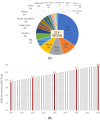Roadmap for achieving net-zero emissions in global food systems by 2050
- PMID: 36065006
- PMCID: PMC9442557
- DOI: 10.1038/s41598-022-18601-1
Roadmap for achieving net-zero emissions in global food systems by 2050
Abstract
Food systems (FSs) emit ~ 20 GtCO2e/y (~ 35% of global greenhouse gas emissions). This level tends to raise given the expected increases in food demands, which may threaten global climate targets. Through a rapid assessment, evaluating 60+ scenarios based on existing low-emission and carbon sequestration practices, we estimate that intensifying FSs could reduce its emissions from 21.4 to - 2.0 GtCO2e/y and address increasing food demands without relying on carbon offsets (e.g., related to afforestation and reforestation programs). However, given historical trends and regional contexts, a more diverse portfolio of practices, including diet shifts and new-horizon technologies, will be needed to increase the feasibility of achieving net-zero FSs. One likely pathway consists of implementing practices that shift food production to the 30th-percentile of least emission-intensive FSs (~ 45% emissions reduction), sequester carbon at 50% of its potential (~ 5 GtCO2e/y) and adopt diet shifts and new-horizon technologies (~ 6 GtCO2e/y). For a successful transition to happen, the global FSs would, in the next decade (2020s), need to implement cost-effective mitigation practices and technologies, supported by improvements in countries' governance and technical assistance, innovative financial mechanisms and research focused on making affordable technologies in the following two decades (2030-2050). This work provides options and a vision to guide global FSs to achieving net-zero by 2050.
© 2022. The Author(s).
Conflict of interest statement
The authors declare no competing interests.
Figures




References
-
- IPCC. Climate Change 2022: Mitigation of Climate Change. Contribution of Working Group III to the Sixth Assessment Report of the Intergovernmental Panel on Climate Change (eds Shukla, P. R. et al.) 10.1017/9781009157926 (Cambridge University Press, 2022).
-
- IPCC. Climate Change 2014: Synthesis Report. Contribution of Working Groups I, II and III to the Fifth Assessment Report of the Intergovernmental Panel on Climate Change, Core Writing Team (eds Pachauri, R. K. et al.) (Intergovernmental Panel on Climate Change IPCC, 2014).
-
- Hasegawa T, Fujimori S, Frank S, Humpenoder F, Bertram C, Després J, Drouet L, Emmerling J, Gusti M, Harmsen M, Keramidas K, Ochi Y, Oshiro K, Rochedo P, van Ruijven B, Cabardos A, Deppermann A, Fosse F, Haylik P, Krey V, Popp A, Schaeffer R, van Vuuren D, Riahi K. Land-based implications of early climate actions without global net-negative emissions. Nat. Sustain. 2021;4:1052–1059. doi: 10.1038/s41893-021-00772-w. - DOI
-
- Roe S, Streck C, Beach R, Busch J, Chapman M, Daioglou V, Deppermann A, Doelman J, Emmet-Booth J, Engelmann J, Fricko O, Frischmann C, Funk J, Grassi G, Griscom B, Havlik P, Hanssen S, Humpenöder F, Landholm D, Lomax G, Lehmann J, Mesnildrey L, Nabuurs G, Popp A, Rivard C, Sanderman J, Sohngen B, Smith P, Stehfest E, Woolf D, Lawrence D. Land-based measures to mitigate climate change: Potential and feasibility by country. Glob. Change Biol. 2021 doi: 10.1111/gcb.15873. - DOI - PMC - PubMed
Publication types
MeSH terms
Substances
LinkOut - more resources
Full Text Sources

